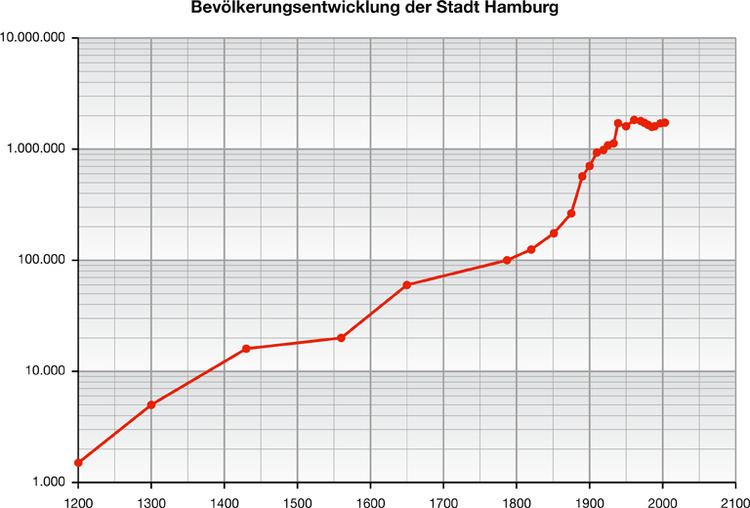 | ||
The German city of Hamburg is the most populous city in the European Union which is not a national capital. The city contains an approximate 1.8 million people.
Contents
The figures since 1970 are published by the Statistical Office for Hamburg and Schleswig Holstein, based on the information of several state authorities.
Historic population data
Hamburg was by far the most populated German City after the Thirty Years' War. Due to its fortifications, which had been finished 1625, the city was never conquered and many people fled into it.
Population
On December 31, 2006 there were 1,754,182 registered people living in Hamburg (up from 1,652,363 in 1990). The population density was 2,322/km2 (6,010/sq mi).
There were 856,132 males and 898,050 females in Hamburg. For every 1,000 males there were 1,049 females. In 2006 there were 16,089 births in Hamburg, of which 33.1% were given by unmarried women, 6,921 marriages and 4,583 divorces. In 2006, 198 registered partnerships took place at the civil registration office (Standesamt). 40 partnerships were dissolved by court order since 2001. In the city the population was spread out with 15.7% under the age of 18, and 18.8% were 65 years of age or older. 257,060 resident aliens were living in Hamburg (14.8% of the population). The largest group are with only Turkish citizenship with 58,154 (22.6% of the resident aliens), followed by 20,743 with only Polish citizenship. 4,046 people were from the United Kingdom and 4,369 were from the United States. According to GTZ, 22,000 immigrants living in Hamburg are from Afghanistan, thus forming the largest Afghan community in Germany and Europe.
After a descent of the population in the 1970s, Hamburg has constantly grown since 1999. Although the numbers of death are higher than the births given. However, Since 2010 the number of births have exceeded the number of deaths.
Households
In 1999 there were 910,304 households, out of which 18.9% had children under the age of 18 living with them and 47.9% of all households were made up of individuals. The average household size was 1.9.
Quarters and boroughs
In 2008 Wandsbek was the most populous borough in Hamburg. Until February 2008 the Harburg borough was the second-most. Through the change of the borders in Hamburg, the quarter Wilhelmsburg merged into Hamburg-Mitte, and Hamburg-Mitte became the second-most populous borough.
Sexual orientation
The Hamburg Institute for Sexual Research conducted a survey over the sexual behavior of young people in 1970, and repeated it in 1990. Whereas in 1970 18% of the boys aged 16 and 17 reported to have had at least one same-sex sexual experience, the number had dropped to 2% by 1990. "Ever since homosexuality became publicly argued to be an innate sexual orientation, boys' fear of being seen as gay has, if anything, increased," the director of the institute, Volkmar Sigusch, suggested in a 1998 article for a German medical journal.
